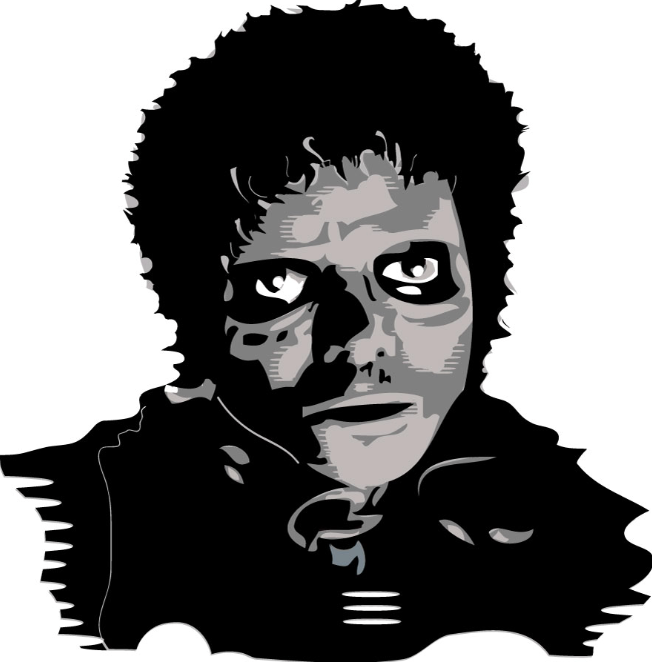Seriously Spooky, Scary Soundtracks of the Season
Think you know the difference between spooky and scary? Staff Writer Luke Deeble ’29 dives into the songs that actually terrify, from Echo & the Bunnymen to Jay-Z, and makes a case for why understanding your fears might be the real trick (or treat).

There is a difference between what we call scary and what we call spooky. While the former refers to a thing’s ability to elicit a fear response from a subject, the latter does not. “Spooky” instead refers to how closely something resembles a trope associated with scariness.
Consider the definitive Halloween song, Michael Jackson’s “Thriller.” To a young child, perhaps, the song is actually scary — particularly Vincent Price’s spoken dialogue, the costumed monsters, and Jackson’s transformation. To the rest of us, however, it is merely spooky, invoking countless clichés associated with scariness without being scary itself.
You may find my perception of these semantics inaccurate. No matter — the point is that Halloween involves distinct aspects of what I call “spookiness” — fun skeleton decorations, etc. — and “scariness,” i.e., horror movies. We are well acquainted with Halloween songs, which tend toward the former. The question before us is this: which songs, in one manner or another, are not merely “spooky” but scary?
“Ocean Rain,” the classic album by post-punk outfit Echo and the Bunnymen, offers our first contenders. Several songs in the album convey a cold, otherworldly eeriness — an effect magnified by the 35-piece orchestra employed on most songs. Many songs feel barren one moment and epic or lavish the next. “The Killing Moon” — erroneously cited as the band’s greatest song — frames a narrator’s pursuit of a girl in language more apt for deadly fatalism. More frightening is the song “Nocturnal Me,” whose chorus resembles ritual chant. But the album’s most horrifying song is “The Yo Yo Man,” wherein the protagonist is always “up and down” (like a yo-yo, get it?). “There are no inbetweens,” we are told, “when Heaven and Hell collide.” The protagonist is decidedly in Hell — “collecting the bones of [his] friends,” experiencing a creeping cold conveyed precisely by the music. While the lyrics on the album are often overly vague, they are certainly evocative and consistently carried home by the accompanying music.
Next up: “Climbing Up the Walls,” off Radiohead’s classic album “OK Computer.” The song is driven by a slow tom beat and bass swells, over which an array of guitars and creepy effects reminiscent of The Beatles’s “Tomorrow Never Knows” complement Thom Yorke’s subdued, distorted, and scary lyrics. Yorke sings from the perspective of a malicious internal demon, telling his victim: “You know we’re friends till we die.” Most frightening of all is the opacity: “And if you get too far inside / you’ll only see my reflection.” Steven Spielberg discovered in making “Jaws” that the unseen is often scarier than the seen; this is especially true when the unseen is something inside your very self, something that you can neither control nor understand. The song builds to a chaotic, dissonant, and frightening climax.
Jay-Z’s “D’Evils,” off his debut album “Reasonable Doubt,” similarly narrates a protagonist's helplessness at the hands of internal forces — here supernatural in nature. DJ Premier takes a gospel sample and makes it ominous, neatly paralleling the song’s theme of demonic perversion. The song follows a compelling structure: the narrator starts in the present tense, describing his situation – “None of [his] friends speak, [they all] tryna win.” He is shockingly clear-eyed about his reality: he is not a criminal because it is an easy path or he’s desperate — “9-5 is how you survive, I ain’t tryna survive / I’m tryna live it to the limit and love it a lot.” Money is his God, and he doesn’t try to excuse it any more than he tries to change it.
The second verse describes the protagonist’s descent to his present situation from childhood: “We used to fight for building blocks, now we fight for blocks with buildings that make a killing.” Jay-Z masterfully narrates the protagonist’s kidnapping of a childhood friend’s romantic partner, making brilliant use of wordplay along the way: “She said the taste of dollars was shitty so I fed her fifties,” “About his whereabouts I wasn’t convinced/I kept feeding her money till shit started to make sense.” The verse concludes: “Don’t cry it is to be / In time, I take away your miseries and make them mine.” The first two verses only hint at supernatural influence, but the narrator already seems to be without will — he understands he will be haunted by what he has done, but does it all the same.
Only in the final verse are the narrator’s worldly preoccupations explicitly equated with demonic forces. For one line, he resorts to pathetic excuse-making — “Mamma forgive me / I can’t be held accountable, D’Evils beating me down boo” — before returning to form. The song’s most brilliant line is its conclusion: “And even if Jehovah Witness bet he’ll never testify.” The wordplay on “witness” draws a dichotomy between the transcendent and the earthly; the narrator’s apparent invocation of the former only to redirect to the very earthly masterfully embodies the entire song.
If the common approach to horror is to take something human and distort it with a horrifying element, Sufjan Stevens takes an inverse approach in “John Wayne Gacy, Jr.” The track’s title is the name of a real serial killer, so the informed listener knows what the song is about before it begins. More surprising are the opening lyrics:
“His father was a drinker
And his mother cried in bed
Folding John Wayne’s T-Shirts
When the swing sets hit his head”
It is possible to mistakenly read this song as Sufjan Stevens humanizing John Wayne Gacy, a man who murdered 33 boys. The narrator chillingly frames Gacy’s unspeakable atrocities as things he “did” for his victims. But that would certainly be a mistake. It is more accurate to say that Stevens reminds us that he, and by extension we, are of the same species as Gacy. The fundamentally horrifying thing about the song is not Gacy’s acts but the narrator’s conclusion:
“And on my best behavior,
I am really just like him.
Look beneath my floorboards,
For the secrets I have hid.”
The music is ballad-like, but destabilized by atonal piano notes that mimic Gacy’s perversion. Steven’s soft voice briefly intensifies to capture our horror in a devastatingly simple line: “Oh my God.”
There are many more songs that are scary, of course, and possibly scarier. This is not a “most scary” list by any stretch of the imagination. They are, however, songs that are frightening the more that you think about them.
Halloween is a holiday whose virtues go underappreciated. Among these is the value in understanding what you fear. I have seen thematic continuity between these songs I had not seen before I began — evil within one’s self, ineffectiveness of will, the opaque or unknowable. Whether or not these songs scare you, it may be worth reflecting on what it is that does. Take a piece of art that scares you — really scares you. Why does it? You might learn something about yourself.





Comments ()